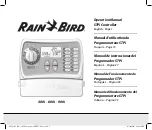Reviews:
No comments
Related manuals for AT-MIO-16

ADwin-Gold
Brand: Jäger Pages: 50

STP-400i
Brand: Rain Bird Pages: 96

AOR-8
Brand: Talkaphone Pages: 39

D 590
Brand: JAMO Pages: 8

R8-YS2
Brand: M-system Pages: 4

HTPS-400
Brand: JBL Pages: 8

1SEK/ME
Brand: Farfisa Pages: 24

DOL 535
Brand: Skov Pages: 68

MLC 9000 Plus
Brand: WEST Pages: 2

STAGE-4 ROKKER XXR Custom
Brand: J&M Corporation Pages: 5

SC-2061
Brand: National Instruments Pages: 77

EH9160PLCW
Brand: FARFISA INTERCOMS Pages: 2

Genie BBSKETDL15B-1001
Brand: Terex Pages: 69

R7E-EC16B
Brand: M-system Pages: 3

KUSB-3160
Brand: Keithley Pages: 59

levelsmart
Brand: H2flow Pages: 16

UV-1G
Brand: Radio Active Designs Pages: 90

95047
Brand: PAPILLON Pages: 8

















